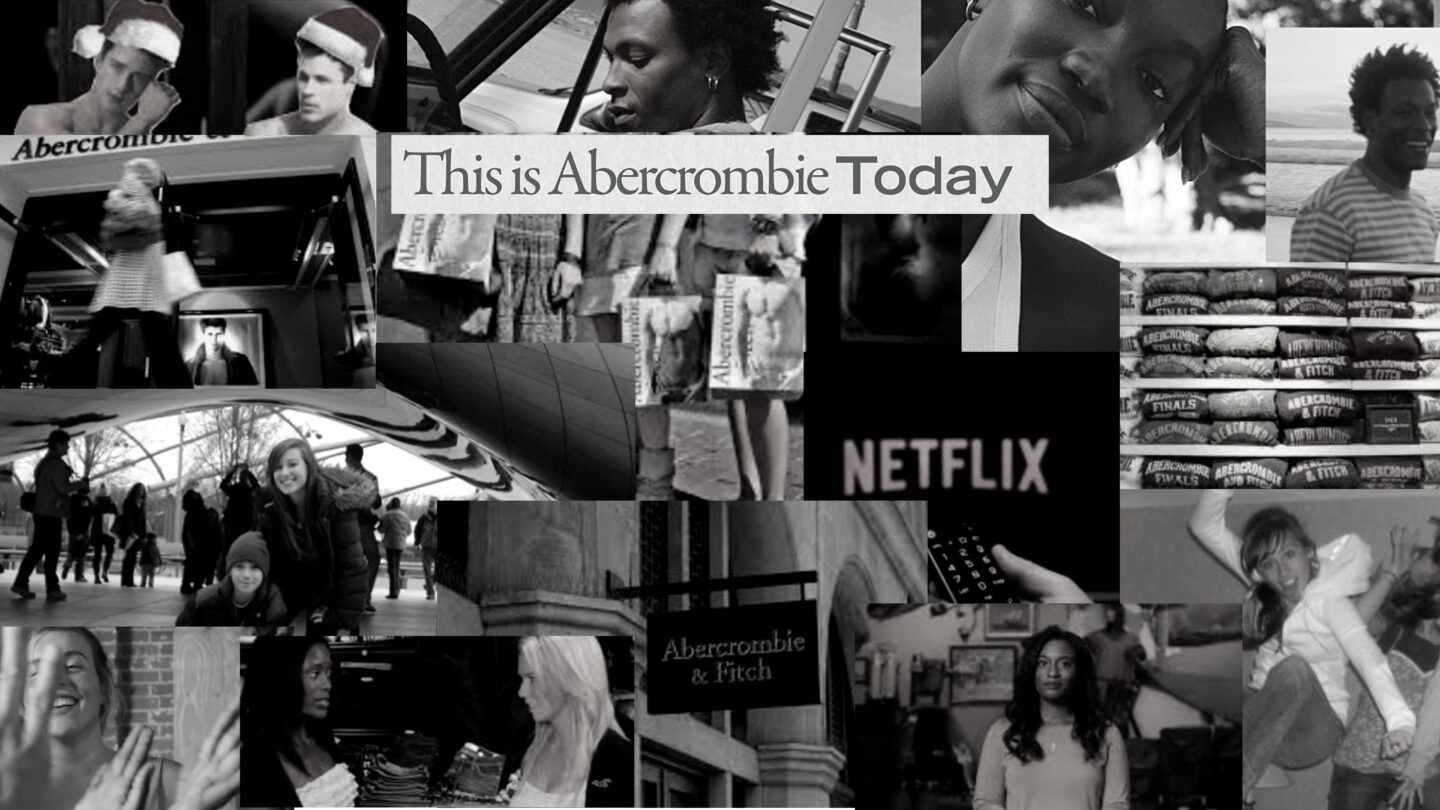
My sharpest memory of Abercrombie and Hollister was going to the mall with friends of mine. We would walk into the dark stores and immediately be hit by the smell. I would also be hit with the feeling of wanting to belong but never feeling like I did. For one, I don’t ever remember buying from either of these mega brand stores. I just couldn’t afford it. I think I had three shirts from Hollister so I had to have bought the shirts at some point, but more often than not I was walking in and out of those stores. I never bought from Abercrombie & Fitch — not once. I remember my mom hating both stores and never buying anything for me besides what was at Kohls. I would buy from American Eagle when I did buy clothes because I always felt like I belonged there. I graduated from high school in 2011 and I wonder if I missed the Abercrombie craze. John and I watched the White Hot: The Rise & Fall of Abercrombie & Fitch on Netflix and we both recalled not liking the people who only wore Abercrombie. Just yesterday we watched Grown Ups 2 and they depicted college kids as bullies and the main characters called these guys “Abercrombie and Fitch”. They mentioned this shift in the documentary and I found it so interesting that even they knew there was a culture problem. Anyways, that’s my background when going into this documentary and here’s a few things I took out or learned from the short documentary on an ultra exclusionary brand.
Exclusivity in Fashion is Not a New Thing.
The exclusivity of Abercrombie & Fitch does not surprise me. What surprised me was how intentional this clothing brand was to make it this way. I just watched a historical youtube video about fashion in the 1800s and it’s not too far off from Abercrombie’s intentions. There were magazines or pamphlets that those in the upper class would create talking about how to tie a necktie. They created the how-to drawings in a way that communicated if you didn’t know how to tie the necktie in correctly you shouldn’t wear it. Etiquette books would be full of these sneaky tricks. This was in place so that if those in the lower class desired to fit in with the upper class, the upper class could spot that person. It’s classism at its finest. That’s what Abercrombie desired to do. There was a “us against them” mentality. This stemmed from the Campus, their headquarters, to the Ambercrombie “models” in the stores.
Creativity wasn’t Celebrated
When I look back on the styles in the early 2000s individuality wasn’t celebrated. This makes me so sad when I think back on it. Psychologists for years have said that fashion is linked to the soul and identity. They believe humans need clothes because of the unique souls they process. Those unique souls should be celebrated in my opinion. I think it’s because we are created by a creative God and clothing shows us that we are to continue to grow. One psychologist said that we are not complete like animals and nature and that is why we wear clothes (Fashion Foundations: Early Writings on Fashion and Dress). Creativity needs to be celebrated along with celebrating differences. It’s how God has designed us. The opposite is oppressive and becomes classist, racist and sexist. I wasn’t surprised when they talked about the dumb t-shirts that raised so much controversy. They were just pushing out products that they thought were making them the most money. They didn’t care about the people who were having to read the captions — they didn’t care about the soul and creativity behind fashion.
“But behind the aura of exclusivity was a policy of, well, exclusivity. In a precursor to today’s influencer marketing, the label hunted out good-looking employees and looked to college fraternities and sororities for models and store workers — a cool-kids-only strategy underpinned by a tacit understanding of whose looks qualified as ‘all-American.’ Former staff members reveal in-house guidelines that fall just short of racially explicit language, though descriptions of dreadlocks as ‘unacceptable,’ for instance, made the implications clear enough to one ex-recruiter, who says: ‘It wasn’t not racist.’” – CNN
Social Media Gave the Customer a Platform
I noticed my little sister, who is nine years younger than I am, starting to wear Hollister in highschool. I was shocked and a little annoyed. However, I think this is around the time when the brand was rebuilding. People were speaking out against the Abercrombie & Fitch brand and they had to change. Through social media these brands started to see there was a problem with their products and with the brand itself. Generation Z wasn’t going to put up with the exclusive brands. They demanded inclusivity and diversity. Those involved with speaking into Abercrombie & Fitch on the documentary said that if it wasn’t for social media they wouldn’t have known that there was so much dissatisfaction with the brand. This is what I love about social media. I thought it was amazingly wild in 2020 when brands were being called out for not having enough people of color in their advertising. We saw a surge of brands having to rethink their marketing. I remember a friend feeling bewildered with how much racism was out there and stated that it feels like the issue was getting worse. I remember reminding her that we are both white and that the reason it feels so much worse now is because we are finally seeing it with our eyes. Social media has exposed what brands were doing in the dark from the top down and brought it into the light for the whole world to see.
A Brand Reflects Leadership
When I was watching the documentary I was appalled at the corruption in leadership. Sexual abuse, all kinds of innapropriate relationships with work and life balance, talking about who was attractive and who wasn’t… just evil. From the top down. I felt with those sharing in the documentary the relief when the CEO of Abercrombie finally stepped down. Mike Jefferies said in an interview, “Are we exclusionary? Absolutely”. And there’s your answer. When Jerfferies stepped down, Fran Horowitz became the new CEO and that’s when the brand went through a rebuilding phase.
“We own and validate that there were exclusionary and inappropriate actions under former leadership,” adding that the company is now “a place of belonging. We’ve evolved the organization, including making changes in management, prioritizing representation, implementing new policies, re-envisioning our store experiences and updating the fit, size-range and style of our products,” – CEO Fran Horowitz told CNN
Today they even use the hashtag #Ambercrombietoday showing a message of moving forward from a past that we all would like to move on from.
No Wonder…
One of the headlines for an article that covered the Netflix Documentary has it all right. “Abercrombie and Fitch told a generation who it was”. I am glad Netflix is peeling back this brand and its rough history. Someone has to talk about it. No wonder eating disorders have gone up so much in recent years and is now one of the deadliest mental health illnesses second to opioid addictions according to ANAD.org. Hospitalizations for eating disorders increased 53 percent from 1999–2000 to 2008–2009 for males and increased 21 percent for female patients according to the National Library of Medicine. I am not saying Abercrombie & Fitch is to blame for all of this, but it definitely didn’t help. I think the writer of the Vox article, Alissa Wilkinson said it well,
“When I look at photos of myself when I was young — meaning high school, I guess — I never thought I was skinny. And I look at pictures now, and I’m like, I was totally skinny, by an objective definition. I think I knew at the time, but obviously it doesn’t change anything. My perception of myself was completely based on a comparative standard, either to whoever the skinniest people were in my social settings, and then also in media. Even so, I was at best wearing the top of the Abercrombie sizes or I was sized out, which has to do with the size of your hips. I think that that stays with you, for sure.”
I think a lot of men and women can relate to this statement. It brings back anxiety, and a lot of weird self-esteem issues that really shouldn’t be there. I love where this next generation is going when it comes to fashion and positive body image. We need to make sure we are caring about the soul behind those clothes and create for that individual beautiful human.
That’s my five thoughts about White Hot: The Rise & Fall of Abercrombie & Fitch on Netflix. I think it shows how fashion, when used to control or elevate a certain type of person, can be really destructive. The documentary shows the positive side of social media — a flashlight that can reveal the deep rooted issues with a brand. It made me proud of not falling into the hype of a branding scheme like Abercrombie & Fitch and validated some of my teenage insecurities that came with the whole exclusive movement that took over my high school years. Leadership matters. An organization will not change until the leadership changes. Why does this matter within the fashion industry? Because fashion moves and changes culture. It really does and we see this with how influential Abercrombie & Fitch was. I would really recommend watching this Netflix documentary. Let’s look forward to a world in fashion where there’s inclusivity and diversity that celebrates the soul of a human.
Have you watched White Hot: The Rise & Fall of Abercrombie & Fitch on Netflix? What did you think? Let me know in the comments
HL






